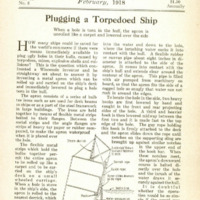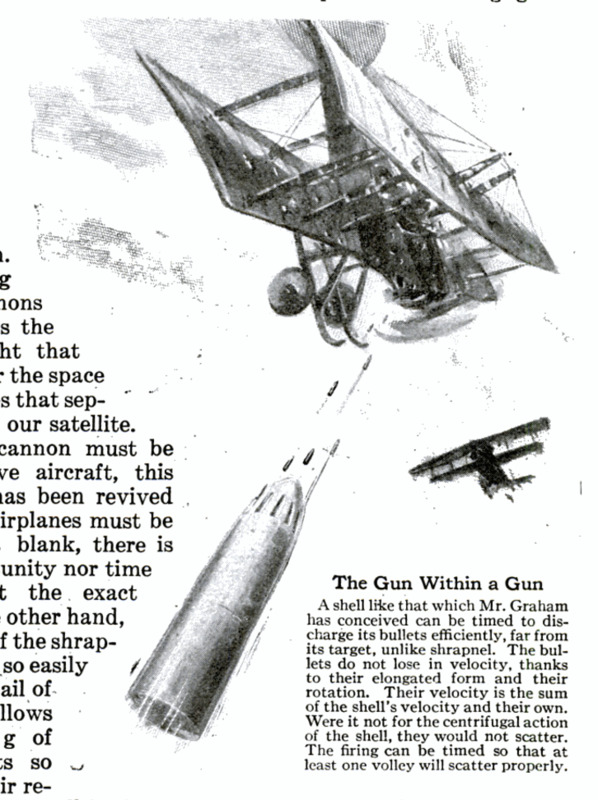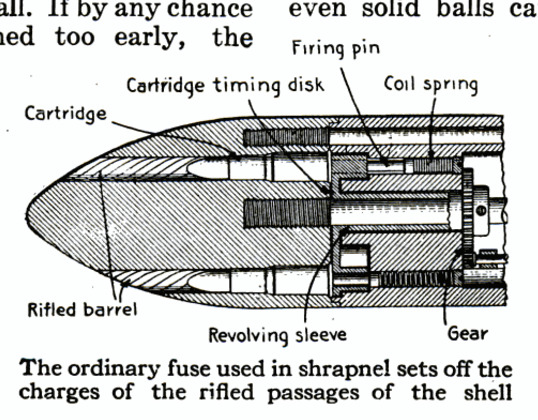Firing a cannon from a cannon
Item
-
Title (Dublin Core)
-
Firing a cannon from a cannon
-
Article Title and/or Image Caption (Dublin Core)
-
Firing a Cannon From a Cannon. An inventor's ingenious plan to bring down aircraft flying at great heights
-
Caption: A shell like that which Mr. Graham has conceived can be timed to discharge its bullets efficiently, far from its target, unlike shrapnel. The bullets do not lose in velocity, thanks to their elongated form and their rotation. Their velocity is the sum of the shell's velocity and their own. Were it not for the centrifugal action of the shell, they would not scatter. The firing can be timed so that at least one volley will scatter properly.
-
extracted text (Extract Text)
-
ONCE upon a time, so an old fairy |
tale runs, a lunatic wanted to bom-
bard the moon. He invented a
shell that was }
in itself a \
cannon
During its
flight, this
projectile-
cannonwould
discharge an-
other shell,
which was ho,
also a cannon. Tn,
And so by firing EL
successive cannons
within cannons the i
lunatic thought that i
he might cover the space
of 260,000 miles that sep-
arates us from our satellite.
Now that cannon must be
fired at elusive aircraft, this ‘
ancient idea has been revived 4
in earnest. Airplanes must be /
fired at point blank, there is
neither opportunity nor time
to figure out the exact
range. On the other hand,
the explosion of the shrap-
nel-shell is riot so easily 74
timed. The hail of
bullets that follows A
the bursting of
shrapnel meets so .,
much more air re- |
~ sistance than the shell itself that not only:
is the scattering effect too great, but the
striking force is too small. If by any chance
the explosion be timed too early, the
scattering effect is
not sufficient and the
airplane is not winged
as a shot-gun wings a
snipe or a quail.
+ Andrew W. Gra-
ham meets this diffi-
culty by inventing a
shell thatisnot merely
an envelope to hold
bullets together for a
certain distance, as in
shrapnel, but which, like that in the fairy
tale, is a gun in itself, and a very
powerful Gatling gun at that.
The projec-
tile is pierced
with a dozen
or so of
rifled chan-
nels, each
constituting
a barrel
loaded with a
regulation
rifle cartridge.
The inventor
has provided
a lock and
firing pin for
each hole and
a clock-work
mechanismto
fire simulta-
neously series
of barrels or
holes. This
mechanism
seems a need-
less and
hardly feasi-
ble complica-
tion. Such is
the concus-
sion in a shell
when it is
fired from a
gun that the
shrapnel balls must be cemented together.
How will clock-work endure a shock that
even solid balls cannot withstand? The
fuse used in shrapnel,
a marvel of accurate
mechanism, adapts
itself to setting off
the charges of the
rifled passages of Mr.
Graham’s shell. By
thus discarding the
clock mechanism, the
barrels or rifled holes
can be made longer,
which means greater
accuracy of fire.
-
Contributor (Dublin Core)
-
Andrew W. Graham (inventor)
-
Language (Dublin Core)
-
eng
-
Date Issued (Dublin Core)
-
1918-02
-
pages (Bibliographic Ontology)
-
241
-
Rights (Dublin Core)
-
Public Domain (Google digitized)
-
Archived by (Dublin Core)
-
Filippo Valle
-
Alberto Bordignon (Supervisor)
 Popular Science Monthly, v. 92, n. 2, 1918
Popular Science Monthly, v. 92, n. 2, 1918





